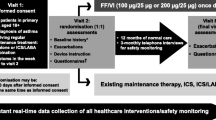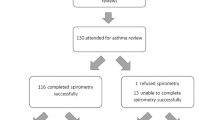Abstract
Objective
We evaluated the adherence to national guidelines for the treatment of asthma in childhood.
Methods
Prescriptions for anti-asthma medication for children (0–14 years of age) were retrieved from the InterAction DataBase (IABD) for the year 2002. These were compared with recommendations found in national guidelines.
Results
Anti-asthma medication was prescribed for 3,612 children (5%) of the paediatric population. Inhaled medication was prescribed for 3,554 (98%) children. In 1,940 of 1,993 (97%) of the children under the age of 6 years pressurised metered dose inhalers (pMDIs) were given. Short-acting β2-agonists had not been prescribed in the previous 2-year period in 559 children (15%), 543 children older than 8 years (36%) did not receive a prescription for a dry powder inhalator and 239 children (7%) had more than one type of inhalator. Long-acting β2-agonists were prescribed in 396 children, but without concomitant inhaled corticosteroids (ICS) in 35 children (9%).
Conclusions
Inhalation therapy as the method of choice in asthma therapy and the use of pMDI in preschool children are widely accepted in the Netherlands. Not all children have been prescribed bronchodilators. Some children have more than one type of inhaler device and others use long-acting β2-agonists not in combination with ICS. Although national and international guidelines about the treatment of asthma in children offer evidence-based advice, important principles are not followed. Effective interventions aimed at implementing existing guidelines into daily practice are urgently needed.
Similar content being viewed by others
Abbreviations
- IADB:
-
InterAction DataBase
- pMDI:
-
Pressurised metered dose inhalator
- DPI:
-
Dry powder inhalator
- SABA:
-
Short-acting β2-agonist
- LABA:
-
Long-acting β2-agonist
- OTC:
-
Over-the-counter
- LTRA:
-
Leucotriene receptor antagonist
- ATC:
-
Anatomical Therapeutic Chemical classification of drugs
References
Altman DG, Machin D, Bryant TN, Gardner MJ (2000) Statistics with confidence. BMJ Books
Anonymous (1997) Asthma in adults and schoolchildren. The General Practitioner in Asthma Group, the British Association of Accident and Emergency Medicine, The British Paediatric Respiratory Society and the Royal College of Paediatrics and Child Health. Thorax 52(suppl 1):s2–s8
Anonymous (1997) Asthma in children under five years of age. The General Practitioner in Asthma Group, the British Association of Accident and Emergency Medicine, The British Paediatric Respiratory Society and the Royal College of Paediatrics and Child Health. Thorax 52(suppl 1):s9–s20
Anonymous (2004) ATC classification index with DDDs. WHO Collaborating Centre for Drug Statistics Methodology, Oslo, January
de Baets F, van Daele S, Franckx H, Vinaimont F (1998) Inhaled steroids compared with disodium cromoglycate in preschool children with episodic viral wheeze. Pediatr Pulmonol 25:361–366
Beimfohr C, Maziak, W, Von Mutius E, Hense HW, Leupold W, Hirsch T, Keil U, Weiland SK (2001) The use of anti-asthmatic drugs in children: results of a community-based survey in Germany. Pharmacoepidemiol Drug Saf 10:315–321
Cabana MD, Rand CS, Becher OJ, Rubin HR (2001) Reasons for pediatrician nonadherence to asthma guidelines. Arch Pediatr Adolesc Med 155:1057–1062
Child F, Davies S, Clayton S, Fryer AA, Lenney W (2002) Inhaler devices for asthma: do we follow the guidelines? Arch Dis Child 86:176–179
Dashash NA, Mukhtar SH (2003) Prescribing for asthmatic children in primary care. Are we following guidelines? Saudi Med J 24:507–511
Dirksen WJ, Geijer RMM, de Haan M, Koning G, Flikweert S, Kolnaar BGM (1998) Guidelines for the treatment of asthma by general practitioners. Huisarts Wet 41:103–143
Global Initiative for Asthma (GINA) (2002) Global strategy for asthma management and prevention. National Institutes of Health. National Heart, Lung, and Blood Institute. Bethesda, MD
Haby MM, Powell CV, Oberklaid F, Waters EB, Robert CF (2002) Asthma in children: gaps between current management and best practice. J Paediatr Child Health 38:284–289
Hoekstra MO (1997) Medical treatment of asthma in children; revised guidelines by paediatric pulmonologists. Ned Tijdschr Geneeskd 141:2223–2228
de Jong-Van den Berg LTW, Feenstra N, Sorensen HT, Cornel MC (1999) Improvement of drug exposure data in a registration of congenital anomalies. Pilot-study: pharmacist and mother as sources for drug exposure data during pregnancy. EuroMAP Group. European Medicine and Pregnancy Group. Teratology 60:33–36
Kamps AW, van Ewijk B, Roorda RJ, Brand PL (2000) Poor inhalation technique, even after inhalation instructions, in children with asthma. Pediatr Pulmonol 29:39–42
Klungel OH, de Boer A, Paes AHP, Herings RMC, Seidell JC, Bakker A (1999) Agreement between self-reported antihypertensive drug use and pharmacy records in a population-based study in the Netherlands. Pharm World Sci 21:218–220
Mutius von E (2003) Epidemiology of allergic diseases. In: Leung DYM, Sampson HA, Geha RS, Szefler SJ (eds) Pediatric allergy, practice and principles. Mosby, St. Louis, pp 1–9
Monster TBM, Janssen WMT, de Jong PE, de Jong-van den Berg LTW (2002) Pharmacoepidemiol Drug Saf 11:379–384
Ng Man Kwong G, Proctor A, Billings C, Duggan R, Das C, Whyte MKB, Powell CVE, Primhak R (2001) Increasing prevalence of asthma diagnosis and symptoms in children is confined to mild symptoms. Thorax 56:312–314
Pedersen S (1994) Inspiratory capacity through Turbuhaler in various patient groups. J Aero Med 7:S55S–S58S
Schirm E, Monster TBM, De Vries R, Van den Berg PB, de Jong-van den Berg LTW, Tobi H (2004) How to estimate the population that is covered by community pharmacies? An evaluation of two methods using drug utilisation information. Pharmacoepidemiol Drug Saf 13:173–179
Shiffman, RN, Freudigman A, Brandt CA, Liaw Y, Navedo DD (2000) A guideline implementation system using handheld computers for office management of asthma: effects on adherence and patient outcomes. Pediatrics 105:767–773
Smeele IJM, Grol RPTM, Van Schayck CP, Van den Bosch WJHM, Van den Hoogen HJM, Muris JWM (1999) Can small group education and peer review improve care for patients with asthma/chronic obstructive pulmonary disease? Qual Health Care 8:92–98
Sookaneknu P, Richards RME, Sanguansermsri J, Teerasut C (2004) Pharmacist involvement in primary care improves hypertensive patient clinical outcomes. Ann Pharmacother 38:2023–2028
Strachan DP (1995) Epidemiology. In: Silvermann M (ed) Childhood asthma and other wheezing disorders. Chapman & Hall, London, pp 7–31
Tobi H, van den Berg PB, de Jong-van den Berg LTW (2000) The InterAction database: synergy of science and practice in pharmacy. Lect Notes Comput Sci 1933:206–211
Tobi H, van den Heuvel NJN, de Jong-van den Berg LTW (2004) Does uncollected medication reduce the validity of pharmacy dispensing data? Pharmacoepidemiol Drug Saf 13:497–500
Van Schayck CP, Smit HA (2005) The prevalence of asthma in children: a reversing trend. Eur Resp J 26:647–650
Veninga CCM, Lagerlov P, Wahlstroem R, Muskova, Denig P, Berkhof J, Kochen MM, Haaijer-Ruskamp FM (1999) Evaluating an educational intervention to improve the treatment of asthma in four European countries. Am J Respir Crit Care Med 160:1254–1262
Verberne AAPH, Frost C, Roorda RJ, Van der Laag J, Kerrebijn KF, The Dutch Paediatric Asthma Study Group (1997) One year treatment with salmeterol compared with beclomethasone in children with asthma. Am J Respir Crit Care Med 156:688–695
Warner JO (2003) Guidelines for treatment of asthma. In: Leung DYM, Sampson HA, Geha RS, Szefler SJ (eds) Pediatric allergy, practice and principles. Mosby, St. Louis, pp 350–356
Acknowledgement
We thank Dr. J. Collins for reviewing the English.
Author information
Authors and Affiliations
Corresponding author
Rights and permissions
About this article
Cite this article
de Vries, T.W., Tobi, H., Schirm, E. et al. The gap between evidence-based medicine and daily practice in the management of paediatric asthma. A pharmacy-based population study from The Netherlands. Eur J Clin Pharmacol 62, 51–55 (2006). https://doi.org/10.1007/s00228-005-0065-z
Received:
Accepted:
Published:
Issue Date:
DOI: https://doi.org/10.1007/s00228-005-0065-z




